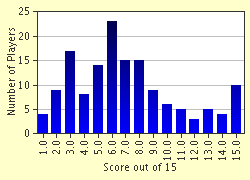Quiz Answer Key and Fun Facts
1. By Islamic tradition the Arabs are descended from Abraham's and Ishamael, the first son of a slave named Hagar. However, the later birth of Isaac (the Jews' ancestor) to Sarah caused friction between the two women, and so Abraham took Hagar and Ishmael to Mecca and left them. What Muslim holy site did God give to Ishmael there?
2. What was the name of Medina before the Hegira?
3. Muhammad died in 632 and the problem arose as to who to should lead the Islamic community. The first four leaders (Caliphs) after Muhammad were known as the 'Rightly guided'. They were (in no particular order) Abu Bakr, Umar, Ali and...?
4. The years after Muhammad's death gave rise to the mass expansion of the Arab world. In just five years the Arabs were strong enough to challenge the mighty empires of Byzantium and Sassanian Persia. In 636 AD the Persian Empire was defeated at what battle?
5. What was the name of the religious sect that assassinated Ali (the fourth Caliph and cousin of the Prophet)?
6. What was the name given to non-Arab Muslims?
7. Upon the death of Ali a new Dynasty rose to power, the Umayyads. What was the name of the first Umayyad Caliph?
8. The Second Civil War (684-692) started with the death of the third Umayyad Caliph Muawiya II. Two claimants to the Caliphate arose; one was Marwan (a member of the Umayyad family). Who was the other?
9. Caliph Abd Al-Malik ruled from 685-705 and was responsible for the introduction of Arabic coinage instead of Byzantium and Sassanian coinage. He also ordered the construction of a famous building completed in 692. What was that building?
10. In the eighth century many Muslims grew discontented with the Umayyad rule. In the Persian Province of Khurasan an ex-slave named Abu Muslim started a revolt against the Umayyads. What year was this?
11. In Abu Muslim's revolt, what colour did the rebels use to represent their resistance?
12. Abu Muslim's revolt was very well organised. It had the clear intention of overthrowing the Umayyads and instating Abu Al-Abbas, desendant of Muhammad's uncle, Abbas, as caliph. Abu Al-Abbas had a nickname, Al-Saffah. What did this mean?
13. What was the name of the battle in which Al-Saffah (Abu Al-Abbas) and Abu Muslim defeated the Umayyads in 750?
14. Al-Mansur succeeded Al-Saffah as Caliph in 754. One of his first actions was to move the capital of the Islamic Empire from Damascus to a newly founded city. What city was it that Al-Mansur founded in 762?
15. Charlemagne had diplomatic relations with which Abbasid ruler?
Source: Author
personx
This quiz was reviewed by FunTrivia editor
bloomsby before going online.
Any errors found in FunTrivia content are routinely corrected through our feedback system.

